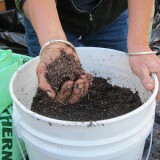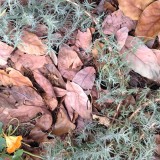First popularized back in the 1970s, “lasagna gardening” involves piling up thick layers of cardboard and uncomposted kitchen scraps on top of (sometimes) double-dug soil. The practice is touted as a way of removing lawns and improving soil with little work.
Linda Chalker-Scott, Extension Urban Horticulturist at Washington State University, proposes a vastly simpler version of lasagna gardening. Chalker-Scott suggests skipping the double digging, cardboard and kitchen scraps. The double digging disrupts soil texture, the cardboard interferes with water penetration (I know this from experience) and the kitchen scraps create a plant nutrient overload. Instead Chalker-Scott suggests simply a very thick layer of mulch–12 inches.
Mulch is often free, as many cities give it away, and it does wonders for the soil. Mulch, in fact, breaks down into soil, retains moisture and creates habitat for earthworms.
Read more in Chalker-Scott’s post, “Is lasagna gardening really worth the effort.“






The cardboard is essential – it keeps aggressive weeds down for years without the effort (and often expenditure) of that much mulch. It’s important to thoroughly soak the ground first, and normal plant-through should insure enough penetrations to allow water infiltration. Mulch holds water that would otherwise run off long enough for the cardboarded earth to absorb it. How do I know? My cardboarded ex-lawn had significantly, visibly less water runoff than the neighbor’s grass.
We don’t have a lawn to kill but have had success with a weed-free garden bed by using the sheet mulching lasagna method. No repeated layers necessary here but the cardboard really does help with moisture retention in the desert. My husband just built a bed this weekend with a layer of aviary wire first (to discourage pocket gophers), then cardboard (free!), a six-inch layer of year-old horse manure (free from the neighbor’s corral), and topped it with a six-inch layer of straw (not free, but inexpensive). For each squash start, he makes a hole in the layers, fills it with soil and plants the start. It works great for us and involves no digging.
I think the success of cardboard varies depending on how much precip your area gets. Here in central NY, we get upwards of 40″ a year and one good downpour has the cardboard disintegrating. I put down cardboard under straw over a large area last June and much of it has already disappeared, but not before it did its job of smothering weeds. I can see where cardboard might be problematic in dry areas though.
I would say double digging is advisable if the soil is as compacted as most lawns tend to be.
I’m a lasagna gardener, and I guess I didn’t research it very thoroughly, but I thought the *point* was not to dig! At least I can say, it works without the digging. In my really weedy yard, I think having that unbroken layer of sod is an extra help with the weed control.
If you have bermuda grass/Cynodon dactylon and live places without a hard freeze (like here in L.A.) be forewarned: bermuda grass can persist quite nicely under all those lasagne layers. Pale and yellowed from lack of sunlight, the bermuda will eventually grow up through the layers of mulch, all through your new garden. Better to truly remove the bermuda (i.e. dig it out carefully. never rototill bermuda, because that just chops it up into bits and each bit resprouts.) and then start your soil improvements.
Here in our Westchester garden we removed the bermuda, then did an intensive program of composting. We did add a one-time dose of beneficial bacteria and mycorrhizae to launch the soil life (read Teaming with Microbes – great book), and we used innoculant with our legume/pea/bean plantings. Worked great!
Also, I don’t recommend free city mulch on food growing beds because you don’t know what is in the city mulch. I’d use it on pathways and ornamentals only. Free city mulch here in L.A. is the contents of your local neighborhood green bins, thus is only as good as what all your neighbors put in the green bin. We’ve found glass, trash, etc in there, which leaves you to wonder about chemicals, plant diseases, noxious weeds, and dog poo. (eeew!)
There are lots of sources of cleaner free mulch for your food areas. I encourage people to look at their waste stream: for example my neighbor planted a deciduous tree on our lotline and it dumps leaves on my property each year. Or look around your neighborhood for unwanted liquid amber or sycamore leaves, pine needles, etc. Clean wonderful mulch.
Ruth Stout in the 50’s-60’s advocated deep deep mulch. Just keeping it deep. I tried this in a Kansas garden and had tomatoes still popping out in november. That Bermuda grass is really tough. But I did have success with card board and mulch in Florida by laying down more layers of cardboard. It did really take a couple of years before even those yellow runners decided to go else where.
I second the usefulness of that bottom layer of cardboard in central NY, where the snow and rains keep things moist. We’re in our third gardening season in a house with a big weedy yard, and cardboard has made our creation of beds work. The worms love it, and we get to use the beds the first year. Then they get better every year even though we have to beg leaves from the neighbors to get enough to create compost.
You just can’t say one thing is good for every area. We all have to make it work the way it works for where we are. Here, for example, the city gives away tons of free compost, but it’s awful stuff. I won’t let it anywhere near my garden. But cardboard? My earthworms say “YUM!”
(Thanks for the wonderful blog!)
It sounds as though people are using “mulch” to mean what we would call compost? “Mulch” here means uncomposted plant material – shredded bark, or leaves, or straw . . . (it was straw that Ruth Stout was using, as I recall). Put down over the soil and around the plants, it helps retain water and reduces weeds – the thicker, the better. But not something you actually plant in.
In my raised beds southwest of San Antonio TX I use layers of goodies for the soil, lay my driplines on top of that, and then put on a layer of cardboard or very thick layer of newspapers, topped off with more mulch. The cardboard or thick newspaper layer is essential for keeping the soil moist here, where it’s hot and often windy. The cardboard doesn’t completely decompose and in the winter I remove what remains and reinstall new cardboard.
My own experience and training agree with Chalker-Scott’s.
Digging is bad no matter where you are because of the destruction of soil structure. Tilling is even worse.
Using 4 sheets of wet newspaper instead of cardboard works even in dry climates.
I am writing a post on this with our full process used to take over weedy areas and lawn.
The myths around double digging and sheet composting are well worth debunking.
@Andrew, I’ve heard that Sheetrock from construction stripped of it’s paper and broken up is great for softening hard compact clay soils. It doesn’t change soil pH.
Pingback: Garden Planning | LinderCroft
Pingback: Top Soil in Aberdeen?
Pingback: Preparing for 2013 | Rox, Seeds, & Soil
Pingback: Lasagne anyone? | Old School Garden
That Bermuda grass is really tough. But I did have success with card board and mulch in Florida by laying down more layers of cardboard. It did really take a couple of years before even those yellow runners decided to go else where.
lawnz.org.uk
Oh, such great information, although some disagree with methods, but that goes back to what one poster said about different climates and conditions being significant to outcome.
I have already made the mistake of piling my two new raised beds with large,leathery oak leaves that I did not shred first. It is time to plant some vegetables in my zone (7), and my leaves look just like they did when they fell in the fall. Maybe I will get better decomposition after the weather warms more. I wet the leaves some and covered the beds with black plastic. If that does not work, I will get out the mower, plow the leaves, dump them back on the beds, and see what happens after a period of waiting.
Oak leaves are chocked full of tannins, so they break down very, very sloooooowwwwwllly. If you have any other options, use those.
Pingback: Lasagne anyone? | Old School Garden